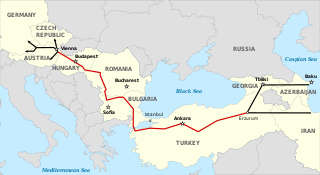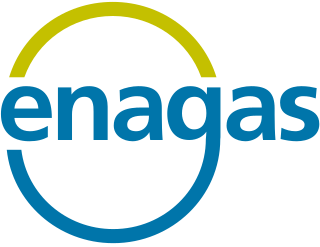
The Federal Energy Regulatory Commission (FERC) is the United States federal agency that regulates the transmission and wholesale sale of electricity and natural gas in interstate commerce and regulates the transportation of oil by pipeline in interstate commerce. FERC also reviews proposals to build interstate natural gas pipelines, natural gas storage projects, and liquefied natural gas (LNG) terminals, in addition to licensing non-federal hydropower projects.

OMV is an Austrian multinational integrated oil, gas and petrochemical company which is headquartered in Vienna, Austria. The company is listed on the Vienna Stock Exchange. In the 2020 Forbes Global 2000, OMV Group was ranked as the 441st -largest public company in the world.

MOL Plc., also commonly known as MOL Group, is a Hungarian multinational oil and gas company headquartered in Budapest, Hungary. Members of MOL Group include among others the Croatian and Slovak formerly state-owned oil and gas companies, INA and Slovnaft. MOL is Hungary's most profitable enterprise, with net profits of $770 million in 2019. The company is also the third most valuable company in Central and Eastern Europe and placed 402 on the Fortune Global 500 list of the world's largest companies in 2013 with a revenue equal to one fifth of Hungary's GDP at the time.

A Transmission System Operator (TSO) is an entity entrusted with transporting energy in the form of natural gas or electrical power on a national or regional level, using fixed infrastructure. The term is defined by the European Commission. The certification procedure for Transmission System Operators is listed in Article 10 of the Electricity and Gas Directives of 2009.

The Nabucco pipeline was a natural gas pipeline project from Erzurum, Turkey to Baumgarten an der March, Austria to diversify natural gas suppliers and delivery routes for Europe. The pipeline was to lessen European dependence on Russian energy. The project was backed by several European Union states and the United States and was seen as rival to the Gazprom-Eni South Stream pipeline project. The main supplier was to be Iraq with potential supplies from Azerbaijan, Turkmenistan, and Egypt.

Enagás, S.A. is a Spanish energy company and European transmission system operator (TSO), which owns and operates the nation's gas grid. The firm also owns four liquefied natural gas regasification terminals in the country, at Huelva, Barcelona, Cartagena and Gijon. In addition, it owns 50% of the plant BBG (Bilbao) and 72.5% of the Saggas terminal in Sagunto. The chairman of Enagás is Antonio Llardén Carratalá and his Chief Executive Officer is Arturo Gonzalo Aizpiri. The firm's headquarters are located in Madrid. Apart from Spain, Enagás has presence in Mexico, Perú, Chile, Sweden and in the Trans Adriatic Pipeline (TAP) European project.
ENTSO-E, the European Network of Transmission System Operators, represents 39 electricity transmission system operators (TSOs) from 35 countries across Europe, thus extending beyond EU borders. ENTSO-E was established and given legal mandates by the EU's Third Package for the Internal energy market in 2009, which aims at further liberalising the gas and electricity markets in the EU.
Transgaz is a state-owned company, which is the technical operator of the national natural gas transmission system in Romania. The company handled in 2017 a quantity of 12.87 billion m³ of natural gas.

Societatea Națională de Gaze Naturale Romgaz SA Mediaș or simply Romgaz is the largest natural gas producer in Romania and one of the largest producers in Eastern Europe. The company is the country's main supplier and responsible for producing around 40% of the total natural gas consumption in Romania.

South Stream was a pipeline project to transport natural gas of the Russian Federation through the Black Sea to Bulgaria and through Serbia, Hungary and Slovenia further to Austria.
LNG Hrvatska d.o.o. is a company that operates a floating liquefied natural gas (LNG) regasification terminal in Omišalj on the island of Krk, Croatia. It commenced operations on 1 January 2021, with full capacity booked for the next three years.
Plinacro is a natural gas transmission system operator in Croatia.
The Arad–Szeged pipeline is a natural gas pipeline from Arad in Romania to Szeged in Hungary diversifying natural gas suppliers and delivery routes for the two countries and connects the two natural gas national grids. The pipeline attempts to lessen the two country's dependence on Russian energy. The Arad–Szeged pipeline is part of the larger New European Transmission System meant to unite Central and South Eastern Europe's natural gas transmission networks.

Romania has proven natural gas reserves of 726 billion cubic meters and is ranked 30th among countries with proved reserves of natural gas. About 75% of Romania's natural gas resources are located in Transylvania, especially in Mureș and Sibiu counties. The largest natural gas field in Romania is the Deleni gas field discovered in 1912 and located in the Băgaciu commune in Mureș County with proven reserves of 85 billion cubic meters or 3 trillion cubic feet. Other important gas fields include the Filitelnic gas field, the Roman-Secuieni gas field, the Voitinel gas field, the Ghercești gas field and the Sărmașel gas field all with reserves larger than 10 billion cubic meters or 350 billion cubic feet. Currently Romania has the second largest natural gas reserves in the European Union just after the Netherlands.
The Giurgiu–Ruse pipeline will be a natural gas pipeline from Giurgiu in Romania to Ruse in Bulgaria diversifying natural gas suppliers and delivery routes for the two countries and connects the two natural gas national grids. The Giurgiu–Ruse pipeline will be part of the larger New European Transmission System meant to unite Central and South Eastern Europe's natural gas transmission networks.
KOSTT j.s.c is a transmission system operator company with the headquarters in Pristina, Kosovo. It plays an important role in the energy sector in Kosovo. As a market operator it is responsible for the organization and administration of trades in electricity and the management of the settlement process. It is a member of the Energy Community. KOSTT is control area and It is synchronously connected with Continental Europe and cooperating with RG CE TSOs to abide by the EU packages. It expects to become a member of the European Network of Transmission System Operators for Electricity in the future.
IP Systems Ltd. is a consultancy and IT solution provider specialized for the liberalized European energy market. Its applications support the whole energy trading process from forecasting and nomination to allocation and accounting.
The Commission for Regulation of Utilities (CRU), formerly known as the Commission for Energy Regulation, is the Republic of Ireland's energy and water economic utility regulator.








